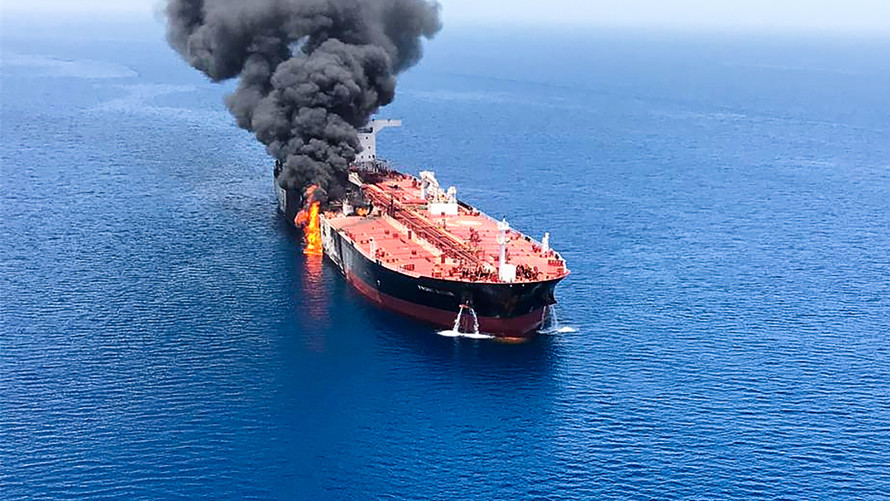
Oil futures rallied Thursday, as an attack on two oil tankers near the Strait of Hormuz raised fears of a potential disruption to the global flow of oil, but failed to recoup the previous days losses by the close.
“Supply concern flare-ups are not infrequent occurrences in crude markets,” said Ryan Giannotto, director of research at GraniteShares.
“The nature of these events is that the outcomes are quite binary: either a major supply disruption event transpires or it does not,” he said. “This lack of a middle ground in outcomes stokes fear in commodities markets, but the added risk premium tends to abate rapidly.”
West Texas Intermediate crude for July delivery CLN19, +0.40% rose $1.14, or 2.2%, to end at $52.28 a barrel after tapping an intraday high of $53.45. The gains contrasted with a 4% drop that took the U.S. benchmark down to $51.14 Wednesday, the lowest front-month contract finish since Jan. 14, according to Dow Jones Market Data.
August Brent crude BRNQ19, +0.78% climbed $1.34, or 2.2%, to $61.3, following a session high so far of $62.64 a barrel, reached earlier when reports of the tanker attacks surfaced. The previous session saw Brent tumble 3.7% to $59.97 a barrel, the lowest front-month finish since Jan. 28.
The “durability of the recovery” for oil prices “will relate to how significant the loss of exports might be and whether there are any further tensions such as military action,” Marshall Steeves, energy markets analyst at Informa Economics, told MarketWatch.
Wednesday’s fall came after a report showing U.S. crude inventories climbed for a second week in a row. Simmering worries about energy demand on the back of growing U.S.-China trade tensions also pressured the commodity.
Geopolitical tensions jolted the price the other way on Thursday. U.S. Secretary of State Mike Pompeo, accused Iran of orchestrating a series of attacks on tankers in an effort to get the U.S. ease up on sanctions. Two ships were damaged in Thursday’s attacks, which underlined fears of disruptions in the Strait of Hormuz, a narrow waterway that is seen as the world most sensitive crude transportation choke point.
“We know that geopolitical tensions in the region are worsening and raise supply-side concerns in terms of short-term outages etc.—but with OPEC already curbing output and U.S. production at a record high the market is far less susceptible to a shock,” said Neil Wilson, chief market analyst for Markets.com, in a note to clients.
Analysts at Commerzbank said the sharp rebound in prices may also be in response to Wednesday’s slump, “which in our opinion was not justified,” it told clients in a note.
“While U.S. crude oil stocks did continue to rise, contrary to expectations, they did so to a lesser extent than the API had reported the evening before. What is more, the refineries processed more crude oil and the gasoline inventory build was much smaller than in the preceding weeks,” said the analysts.
However, threats to the region are taken seriously as it is a vital shipping route for oil production around the Persian Gulf. The region has been the site of other attacks. On May 14, Yemen’s Houthi rebels, who are fighting Saudi Arabia, claimed responsibility for armed-drone attacks that halted pumping at a key Saudi oil pipeline. A day ahead of that incident, the Saudis said two of their tankers had been damaged in a sabotage attack. The U.S. has been blaming Iran for those attacks.
The attacks on the two tankers occurred as Japan’s Prime Minister Shinzō Abe was on a mission to ease tensions between the U.S. and Iran. Anas Alhajji, an independent energy expert, suggested that this “indicates that rogue elements within the Iranian regime want to derail any efforts for negotiations.”
Also Thursday, the Organization of the Petroleum Exporting Countries cut its forecast for growth in world oil demand this year to 1.14 million barrels a day, from a May estimate of 1.21 million barrels. In its monthly report, OPEC said the revision largely reflected sluggish demand data from developed countries that make up the Organization for Economic Cooperation and Development.
The International Energy Agency will be released its own monthly oil report on Friday. That report will include forecasts for 2020.
The market is awaiting a decision by OPEC and its allies on whether to extend their production-cut deal past the end of this month, when it expires.
In other energy trading, July gasoline RBN19, +0.64% rose 2% to $1.7199 a gallon, while July heating oil HON19, +0.65% rose 1.5% to $1.8066 a gallon.
Natural-gas futures fell after the EIA Thursday said U.S. supplies of the commodity rose by 102 billion cubic feet for the week ended June 7. The average forecast of analysts polled by S&P Global Platts had called for an increase of 108 billion cubic feet.
July natural gas NGN19, +0.43% dropped 2.6% to close at $2.325 per million British thermal units.

